Toshiba K Series User Manual

Owner’s Manual
Hard Disk Camera
GSC-K80HE/GSC-K40HE
computers.toshiba-europe.com

Hard Disk Camera GSC-K80HE/GSC-K40HE
ii |
Owner’s Manual |

Hard Disk Camera GSC-K80HE/GSC-K40HE
Table of Contents
Preface
Before Using Your Camera . . . . . . . . . . . . . . . . . . . . . . . . . . . . . . . . . viii Check the components . . . . . . . . . . . . . . . . . . . . . . . . . . . . . . . . . . . . . . x Specifications . . . . . . . . . . . . . . . . . . . . . . . . . . . . . . . . . . . . . . . . . . . . . xi Safety Precautions . . . . . . . . . . . . . . . . . . . . . . . . . . . . . . . . . . . . . . . . xiii Handling Your Camera . . . . . . . . . . . . . . . . . . . . . . . . . . . . . . . . . . . . xviii Handling the AC Adapter . . . . . . . . . . . . . . . . . . . . . . . . . . . . . . . . . . . . xx Handling the Battery . . . . . . . . . . . . . . . . . . . . . . . . . . . . . . . . . . . . . . xxi About the Built-in Hard Disk Drive . . . . . . . . . . . . . . . . . . . . . . . . . . xxiii About SD Memory Cards . . . . . . . . . . . . . . . . . . . . . . . . . . . . . . . . . . xxiv
Chapter 1 Preparation
Component Names. . . . . . . . . . . . . . . . . . . . . . . . . . . . . . . . . . . . . . . . . . 2 Loading and Removing the Battery . . . . . . . . . . . . . . . . . . . . . . . . . . . . 5 Charging . . . . . . . . . . . . . . . . . . . . . . . . . . . . . . . . . . . . . . . . . . . . . . . . . . 6 Inserting and Removing SD Cards . . . . . . . . . . . . . . . . . . . . . . . . . . . . . 8 Turning the Camera On and Off . . . . . . . . . . . . . . . . . . . . . . . . . . . . . . . 9 Setting the Date and Time . . . . . . . . . . . . . . . . . . . . . . . . . . . . . . . . . . . 11 Creating Albums. . . . . . . . . . . . . . . . . . . . . . . . . . . . . . . . . . . . . . . . . . . 12 Using the LCD Monitor. . . . . . . . . . . . . . . . . . . . . . . . . . . . . . . . . . . . . . 14 About the Remote Control. . . . . . . . . . . . . . . . . . . . . . . . . . . . . . . . . . . 15 Using the Conversion Lens or Lens Hood. . . . . . . . . . . . . . . . . . . . . . 17
Chapter 2 Shooting Video
Before You Shoot . . . . . . . . . . . . . . . . . . . . . . . . . . . . . . . . . . . . . . . . . . 20 Shooting Video . . . . . . . . . . . . . . . . . . . . . . . . . . . . . . . . . . . . . . . . . . . . 22 Taking Still Images . . . . . . . . . . . . . . . . . . . . . . . . . . . . . . . . . . . . . . . . . 25 Shooting with the Zoom. . . . . . . . . . . . . . . . . . . . . . . . . . . . . . . . . . . . . 27 Playback . . . . . . . . . . . . . . . . . . . . . . . . . . . . . . . . . . . . . . . . . . . . . . . . . 28 Erasing Images (Erase one Image) . . . . . . . . . . . . . . . . . . . . . . . . . . . . 32
Chapter 3 Advanced Photography
Setting the Scene . . . . . . . . . . . . . . . . . . . . . . . . . . . . . . . . . . . . . . . . . 34 Setting the Focus . . . . . . . . . . . . . . . . . . . . . . . . . . . . . . . . . . . . . . . . . 36 Changing the Brightness . . . . . . . . . . . . . . . . . . . . . . . . . . . . . . . . . . . 38 Using the Backlight Compensation Function . . . . . . . . . . . . . . . . . . . 39 Using Auto Mode Function . . . . . . . . . . . . . . . . . . . . . . . . . . . . . . . . . . 40 Photography Using the Assist Light . . . . . . . . . . . . . . . . . . . . . . . . . . 41 Changing the Recording Menu Settings . . . . . . . . . . . . . . . . . . . . . . . 42 Creating and Selecting Albums . . . . . . . . . . . . . . . . . . . . . . . . . . . . . . 45 Continuous Recording . . . . . . . . . . . . . . . . . . . . . . . . . . . . . . . . . . . . . 48 Setting the Video Quality . . . . . . . . . . . . . . . . . . . . . . . . . . . . . . . . . . . 49
Owner’s Manual |
iii |

Hard Disk Camera GSC-K80HE/GSC-K40HE
Shooting with Natural Color Tones (White Balance) . . . . . . . . . . . . . 50 Shooting with Image Stabilization . . . . . . . . . . . . . . . . . . . . . . . . . . . . 52 Wind Noise Reduction . . . . . . . . . . . . . . . . . . . . . . . . . . . . . . . . . . . . . 53 Changing the Microphone Sensitivity . . . . . . . . . . . . . . . . . . . . . . . . . 54 Digital Zooming . . . . . . . . . . . . . . . . . . . . . . . . . . . . . . . . . . . . . . . . . . . 55 Selecting the Metering Mode . . . . . . . . . . . . . . . . . . . . . . . . . . . . . . . . 56 Selecting the Focus Area (AF Mode) . . . . . . . . . . . . . . . . . . . . . . . . . . 57 Shooting with AF Assist Light . . . . . . . . . . . . . . . . . . . . . . . . . . . . . . . 58 Changing Image Colors . . . . . . . . . . . . . . . . . . . . . . . . . . . . . . . . . . . . 59 Changing the Image Contrast . . . . . . . . . . . . . . . . . . . . . . . . . . . . . . . 60 Changing the Image Sharpness . . . . . . . . . . . . . . . . . . . . . . . . . . . . . . 61 Changing the LCD Brightness . . . . . . . . . . . . . . . . . . . . . . . . . . . . . . . 62
Chapter 4 Advanced Playback
Changing Levels. . . . . . . . . . . . . . . . . . . . . . . . . . . . . . . . . . . . . . . . . . . 66 Selecting the Video Playback Method . . . . . . . . . . . . . . . . . . . . . . . . . 67 Capturing Single Video Frames as Still Images . . . . . . . . . . . . . . . . . 68 Using Zoomed Playback . . . . . . . . . . . . . . . . . . . . . . . . . . . . . . . . . . . . 69 Switching the Playback Display . . . . . . . . . . . . . . . . . . . . . . . . . . . . . 70 Changing Playback Settings. . . . . . . . . . . . . . . . . . . . . . . . . . . . . . . . . 71 Setting up and Running Auto Play . . . . . . . . . . . . . . . . . . . . . . . . . . . 73 Protecting Images . . . . . . . . . . . . . . . . . . . . . . . . . . . . . . . . . . . . . . . . . 75 Copying Images . . . . . . . . . . . . . . . . . . . . . . . . . . . . . . . . . . . . . . . . . . . 78 Printing Directly from the Camera Using PictBridge . . . . . . . . . . . . . 80 Editing Videos . . . . . . . . . . . . . . . . . . . . . . . . . . . . . . . . . . . . . . . . . . . . 82
Chapter 5 Advanced Deletion
Erasing Selected Images. . . . . . . . . . . . . . . . . . . . . . . . . . . . . . . . . . . . 86 Erasing Albums . . . . . . . . . . . . . . . . . . . . . . . . . . . . . . . . . . . . . . . . . . . 88 Erasing all the Files on a Drive . . . . . . . . . . . . . . . . . . . . . . . . . . . . . . . 89
Chapter 6 Basic Camera Settings
Changing the Basic Camera Settings . . . . . . . . . . . . . . . . . . . . . . . . . 92 Sound . . . . . . . . . . . . . . . . . . . . . . . . . . . . . . . . . . . . . . . . . . . . . . . . . . . 94 Auto Power Off . . . . . . . . . . . . . . . . . . . . . . . . . . . . . . . . . . . . . . . . . . . . 95 LCD-linked Power. . . . . . . . . . . . . . . . . . . . . . . . . . . . . . . . . . . . . . . . . . 96 Quick Start . . . . . . . . . . . . . . . . . . . . . . . . . . . . . . . . . . . . . . . . . . . . . . . 97 Output TV . . . . . . . . . . . . . . . . . . . . . . . . . . . . . . . . . . . . . . . . . . . . . . . . 98 LANGUAGE. . . . . . . . . . . . . . . . . . . . . . . . . . . . . . . . . . . . . . . . . . . . . . . 99 System. . . . . . . . . . . . . . . . . . . . . . . . . . . . . . . . . . . . . . . . . . . . . . . . . . 100
Chapter 7 Connecting to a TV
Connecting with HDMI Cable . . . . . . . . . . . . . . . . . . . . . . . . . . . . . . . 106 Connecting with Component Cable . . . . . . . . . . . . . . . . . . . . . . . . . . 107 Connecting with AV Cable. . . . . . . . . . . . . . . . . . . . . . . . . . . . . . . . . . 108
iv |
Owner’s Manual |

Hard Disk Camera GSC-K80HE/GSC-K40HE
Chapter 8 Connecting to a PC
About the Software. . . . . . . . . . . . . . . . . . . . . . . . . . . . . . . . . . . . . . . . 110 Supported PCs . . . . . . . . . . . . . . . . . . . . . . . . . . . . . . . . . . . . . . . . . . . 111 Installing the Software . . . . . . . . . . . . . . . . . . . . . . . . . . . . . . . . . . . . . 112 Backing up Camera Images to a PC . . . . . . . . . . . . . . . . . . . . . . . . . . 115
Appendix Troubleshooting . . . . . . . . . . . . . . . . . . . . . . . . . . . . . . . . . . . . . . . . . . 120
Error Messages. . . . . . . . . . . . . . . . . . . . . . . . . . . . . . . . . . . . . . . . . . . 130 Glossary . . . . . . . . . . . . . . . . . . . . . . . . . . . . . . . . . . . . . . . . . . . . . . . . 131 Index . . . . . . . . . . . . . . . . . . . . . . . . . . . . . . . . . . . . . . . . . . . . . . . . . . . 133 Toshiba Support . . . . . . . . . . . . . . . . . . . . . . . . . . . . . . . . . . . . . . . . . . 135 Regulatory information . . . . . . . . . . . . . . . . . . . . . . . . . . . . . . . . . . . . 135 Trademarks . . . . . . . . . . . . . . . . . . . . . . . . . . . . . . . . . . . . . . . . . . . . . . 137
Owner’s Manual |
v |

Hard Disk Camera GSC-K80HE/GSC-K40HE
vi |
Owner’s Manual |

Hard Disk Camera GSC-K80HE/GSC-K40HE
Preface
Before Using Your Camera
Check the components
Specifications
Safety Precautions
Handling Your Camera
Handling the AC Adapter
Handling the Battery
About the Built-in Hard Disk Drive
About SD Memory Cards
Owner’s Manual |
vii |

Hard Disk Camera GSC-K80HE/GSC-K40HE
Before Using Your Camera
Thank you for buying this Toshiba HARD DISK CAMERA.
To ensure correct use of your hard disk camera, be sure to thoroughly read this Owner’s Manual before you start using the camera.
Always keep this Owner’s Manual close by after you have finished reading it.
The exterior, specifications, software and content of this Owner’s Manual are subject to change without notice in the interest of product improvement.
The illustrations and screen displays in this manual are exaggerated and simplified for ease of viewing, so there can be slight differences between them and the actual product.
In this manual, the  icon indicates functions and settings that apply to
icon indicates functions and settings that apply to
video recording, while the  icon is used to indicate functions and settings that apply to still image photography. Both still images and videos are referred to as “images”.
icon is used to indicate functions and settings that apply to still image photography. Both still images and videos are referred to as “images”.
Software and Owner’s Manual
Neither the entirety nor a portion of the accompanying Software or Owner’s Manual can be transferred or reproduced without permission.
The accompanying Software and Owner’s Manual can be used with a single apparatus.
Please note that we cannot be held liable for damages incurred by you or a third party as a result of using an apparatus with this Software and Owner’s Manual.
Computer screens in the Owner’s Manual are given as an example. These may differ from your actual screen. We cannot be held liable for compensation for errors in description.
Notice Regarding Data Erasure When Discarding or Transferring Rights to Your Camera
When formatting or deleting data from the camera or PC, only the file management information is changed. The data may still be present and could be recovered using commercially available data recovery software. This could allow for data which was erased to fall into the hands of an unintended party.
As a prevention, it is recommended to physically destroy the built-in hard disk drive or SD Memory Card, or to transfer rights or dispose of the camera or SD Memory Card after having completely erased any data on the built-in hard disk drive or SD Memory Card using commercially available data erasing software.
Please responsibly manage data on the built-in hard disk drive and SD Memory Card.
viii |
Owner’s Manual |

Hard Disk Camera GSC-K80HE/GSC-K40HE
Do not use the PC to format the camera built-in hard disk drive or SD Memory Card with PC connection. Format the hard disk drive or SD
Memory Card on the camera ( p.102).
p.102).
CAUTION
RISK OF EXPLOTION IF BATTERY IS REPLACED BY AN INCORRECT TYPE. DISPOSE OF USED BATTERIES ACCORDING TO LOCAL ORDINANCES OR REGULATIONS.
This hard disk camera supports Exif Print.
This product supports PRINT Image Matching III. A faithful reflection of shooting conditions and shooting intentions are possible when printing with a PRINT Image Matchingsupported printer and processing images with compatible software. Some features are not available with printers supporting versions earlier than PRINT Image Matching III.
Owner’s Manual |
ix |
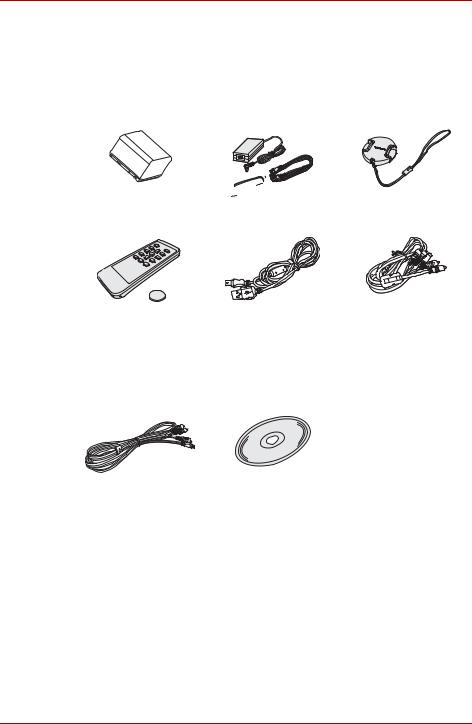
Hard Disk Camera GSC-K80HE/GSC-K40HE
Check the components
Make sure that you have all of the items below. If any item is missing, damaged or mismatched, please contact the Toshiba Support.
Rechargeable |
AC adapter |
Lens cap |
battery (GSC-BT6) |
(SQPH20W10P-02) |
|
 Power cord
Power cord
Remote control |
USB cable |
AV cable |
Battery for remote control
Component cable |
CD-ROM |
|
Application software (1) |
|
Owner’s Manual (1) |
Owner's Manual (this document)
Quick Start Guide
Warranty Leaflet
x |
Owner’s Manual |

|
|
Hard Disk Camera GSC-K80HE/GSC-K40HE |
|
|
|
Specifications |
|
|
|
|
|
|
Image sensor |
1/3-inch CMOS sensor |
|
|
Total pixels: 1.35 million |
|
|
Effective pixels: Still image approx. 920K, video |
|
|
approx. 920K |
|
Lens |
Optical 10X zoom lens, f/3.5 |
|
|
Focal length: f = 6.0-60.0 mm (with 35 mm camera: |
|
|
46.2-503.6 mm) |
|
|
Filter diameter: 43 mm |
|
Shooting range |
Standard: Approx. 0.1 m to infinity (wide-angle), |
|
|
approx. 1.0 m to infinity (telephoto) |
|
LCD monitor*1 |
3.0-inch diagonal TFT color LCD |
|
|
Pixels: 230,000 (960 X 240) |
|
Focus control |
TTL contrast-detection AF |
|
method |
|
|
Exposure control |
Program AE |
|
mode |
|
|
Metering mode |
TTL zoned metering |
|
|
Metering modes: Center-weighted, Spot |
|
Brightness |
-2.0EV to +2.0EV (in 1/3-EV/Step increments) |
|
Still photography |
Auto: ISO100-200 equivalents |
|
sensitivity |
|
|
Shutter speeds |
Videos: 1/15 to 1/4800 sec. |
|
|
Still images: 1 to 1/1000 sec. (combination electronic |
|
|
and mechanical shutter) |
|
Image |
Electronic |
|
Stabilization |
|
|
White balance |
Auto, Sunlight, Cloud, Fluorescent light H, Fluorescent |
|
|
light L, Incandescent lamp, Preset |
|
Digital zoom |
3X |
|
I/O terminals |
DC IN 10 V terminal, USB terminal, A/V OUT terminal, |
|
|
Component terminal, HDMI output terminal (type C) |
|
Power supply |
Dedicated rechargeable lithium-ion battery (GSC-BT6) |
|
|
/ AC adapter (SQPH20W10P-02) |
|
Recording media |
Hard disk drive: 80GB*2 (GSC-K80HE) or |
|
|
40GB*2 (GSC-K40HE) |
|
|
SD Memory Cards: up to 8GB SDHC/SD supported |
Owner’s Manual |
xi |

Hard Disk Camera GSC-K80HE/GSC-K40HE
Videos |
Recording format: MPEG-4 AVC/H.264 (60fps) |
|
Recorded pixels: 1280 X 720 |
|
Audio: AAC, 48kHz, 16-bit, stereo, 128kbps |
Still images |
Recording format: JPEG (Exif 2.21, DCF 2.0-compliant) |
|
Recorded pixels: 920,000 (1280 X 720) |
Operating |
Temperature: +41°F (+5°C) to +104°F (+40°C) |
environment |
(running), -4°F |
|
(-20°C) to +140°F (+60°C) (stored) |
|
Humidity: 30% to 80% RH (running, no condensation) |
Dimensions |
3.4 inches × 3.1 inches × 5.3 inches |
(W × H × D) |
(86.8 mm × 80.0 mm × 135.5 mm) |
|
(including extruding part, battery unloaded) |
|
3.4 inches × 3.1 inches × 5.8 inches |
|
(86.8 mm × 80.0 mm × 146.8 mm) |
|
(including extruding part, battery loaded) |
Weight |
GSC-K80HE: Approx. 18.2 oz (515 g) (camera body |
|
only) |
|
Approx. 20.6 oz (585 g) (including battery, SD card |
|
and lens cover) |
|
GSC-K40HE: Approx. 17.6 oz (500 g) (camera body |
|
only) |
|
Approx. 20.1 oz (570 g) (including battery, SD card and |
|
lens cover) |
*1: The LCD monitor contained in this camera is manufactured using an extremely high level of precision technology; however, there may be an occasional pixel (dot of light) that does not operate properly (e.g., does not light, remains constantly lit, etc.). This is a structural property of LCD technology, is not a sign of malfunction, does not affect continued operation of the LCD monitor, and is not covered under your warranty.
*2: 1GB = 1 billion bytes. Actual formatted capacity may be less.
This model complies with the above specifications.
Designs and specifications are subject to change without notice.
This model may not be compatible with features and/or specifications that may be added in the future.
xii |
Owner’s Manual |
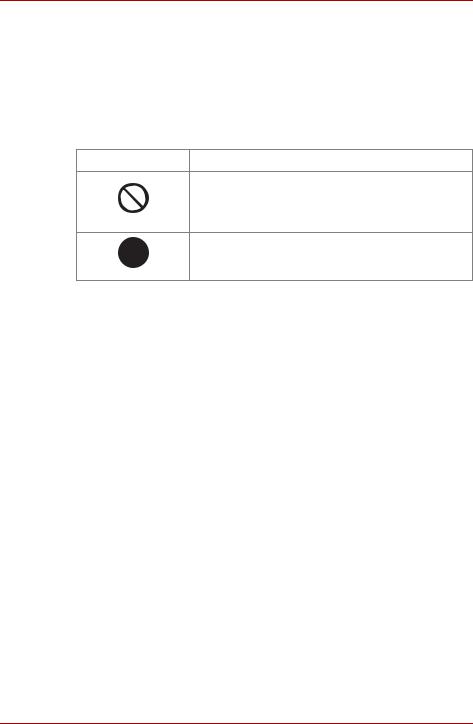
Hard Disk Camera GSC-K80HE/GSC-K40HE
Safety Precautions
Read these safety precautions carefully before using this product.
These precautions provide valuable safety instructions that you must observe.
The indications used for the precautions have the following meanings:
Graphic symbol definitions
Graphic Symbol Meaning
Indicates a prohibited action that must not be carried out. The actual prohibited action is indicated in the symbol or nearby graphically, or described in text.
Indicates a necessary action that must be carried out. The actual necessary action is indicated in the symbol or nearby graphically, or described in text.
Owner’s Manual |
xiii |
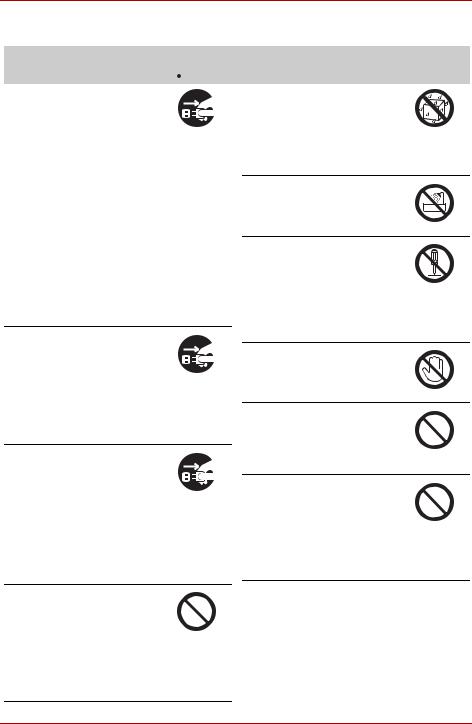
Hard Disk Camera GSC-K80HE/GSC-K40HE
When using the product
 WARNING
WARNING
Should you ever notice a
strange odor, smoke, or excessive heat coming from the camera, remove the battery
and AC adapter.
Continued use in this state might cause fire, electric shock, or burns. Take care not to burn yourself if the battery gets hot. For details on repair, consult the Toshiba Customer Service Department or Toshiba Customer Support Department.
In case of continuous usage for a longer period the surface of your camera may reach a higher temperature which may possibly cause damage to your skin. If temperature of your camera is getting higher turn it off and let it cool down for some time. Please protect your skin from hot surface.
If foreign objects or water have entered the camera, turn the power OFF and remove the battery and AC adapter.
Continued use in this state might cause fire or electric shock. Consult the Toshiba Customer Service Department or Toshiba Customer Support Department.
If the camera has fallen or its case has been damaged, turn the power OFF and remove the battery and AC adapter.
Continued use in this state might cause fire or electric shock. Injury may occur from handling the damaged case.
Consult the Toshiba Customer Service Department or Toshiba Customer Support Department.
Do not allow metallic objects or flammable foreign matter inside the camera.
This might cause fire or electric shock.
Do not insert or drop foreign objects in the SD card slot, terminals, or other holes or openings.
Do not use the camera in areas near water.
This might cause fire or electric shock.
Take special care during rain, snow, on the beach, or near the shore.
Do not use the camera in the bath or shower.
This might cause fire or electric shock.
Do not disassemble, modify, or repair the camera.
This might cause fire or electric shock.
For repair or internal inspection, ask the Toshiba Customer Service Department or Toshiba Customer Support Department.
Do not touch power cables, TV cables, or USB cables during a thunderstorm.
This might cause electric shock.
Do not use the camera while walking, driving, or riding a motorcycle.
This might cause you to fall over or result in a traffic accident.
Do not use the product or carry it close to your body outdoors in the rain, during a thunderstorm or when a thunderstorm is near.
This might cause fire, electric shock and/or serious lightning injuries.
xiv |
Owner’s Manual |
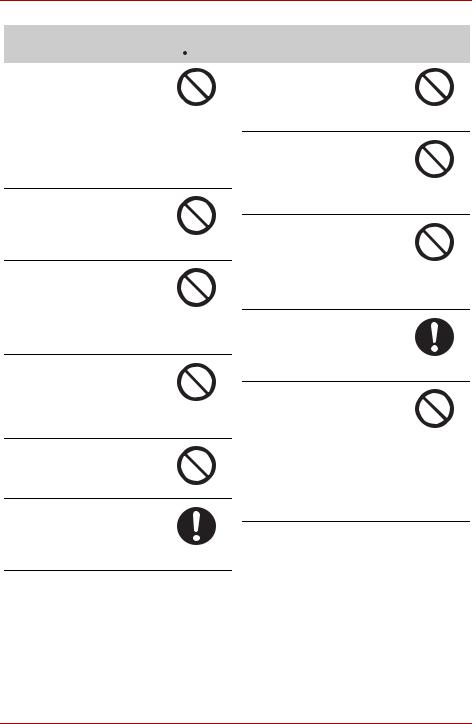
Hard Disk Camera GSC-K80HE/GSC-K40HE
 CAUTION
CAUTION
Turn off power and do not use the camera where its use is restricted, such as in an airplane or hospital.
This might affect flight or medical equipment resulting in accident. Use during airplane take-off/ landing is prohibited by law.
For use in a hospital, consult hospital staff.
Do not use the camera in humid, steamy, smoky, or dusty places.
This might cause fire or electric shock.
Do not leave the camera in places where the temperature may rise significantly, such as inside a car.
This might adversely affect the case or the internal parts, resulting in fire.
Do not play the supplied CDROM with a music CD player or a similar device.
This might damage the headphone or speaker, and/or may damage your ears.
Do not drop or subject the camera to strong impact.
This might cause fire, electric shock, or malfunction.
Before moving the camera, disconnect the cables.
Neglecting this might damage the cables, resulting in fire or electric shock.
Do not place the camera on inclined or unstable surfaces.
This might cause the camera to fall or tilt over, causing injury or malfunction.
Do not wrap or place the camera in cloth or blankets.
This might cause heat to build up and deform the case, resulting in fire. Use the camera in a wellventilated place.
Do not swing the camera while walking.
If you hold the grip belt and swing the camera, the camera might come into contact to other people or any object, resulting in injury or malfunction.
Before cleaning the camera, remove the battery and AC adapter.
Neglecting this might cause electric shock.
Do not subject the LCD monitor to impact.
This might damage the glass on the screen or cause the internal fluid to leak. If the internal fluid enters your eyes or comes into contact with your body or clothes, rinse with fresh water.
If the internal fluid has entered your eyes, consult a physician to receive treatment.
Owner’s Manual |
xv |

Hard Disk Camera GSC-K80HE/GSC-K40HE
About the AC adapter
WARNING
Use the AC adapter only with the indicated power supply voltage.
Use with any other power supply voltage might cause fire or electric shock.
Do not disassemble, modify, or repair the AC adapter.
This might cause fire or electric shock.
Occasionally remove the plug from the outlet and clean the prongs and the surface where the prongs are connected if dust or dirt has adhered.
A loss of plug insulation might cause fire.
Do not bring metal into contact with the connection points of the AC adapter when its plug is in an outlet.
This might cause fire or electric shock.
Do not place blankets over the AC adapter connected with the power source or place the adapter near a heater or on an electric (warm) carpet.
This might cause fire or malfunction.
Observe the following when handling the AC adapter cord.
•Do not damage, modify (e.g., to extend), or heat the AC adapter cable.
•Do not pull the AC adapter cable, place something heavy on it, or pinch it.
•Do not bend, twist, or bundle the AC adapter cable with an excessive force.
These might cause fire or electric shock.
 CAUTION
CAUTION
Do not connect or disconnect the AC adapter plug with a wet hand.
This might cause electric shock.
Do not remove the AC adapter plug from a wall outlet by pulling the actual cable.
This might damage the cable or plug, resulting in fire or electric shock. Make sure to hold the plug when removing it.
Use only the specified AC adapter (SQPH20W10P-02) and power cable.
Use of an AC adapter other than specified might cause fire or malfunction.
If you plan not to use the camera for a long period of time, remove the AC adapter plug from a wall outlet for safety.
Malfunction of the camera, if it happens, might result in fire.
Do not use the AC adapter for any use other than with this camera.
This might cause fire or malfunction.
Firmly insert the AC adapter plug into a wall outlet.
Neglecting this might cause fire or electric shock.
xvi |
Owner’s Manual |
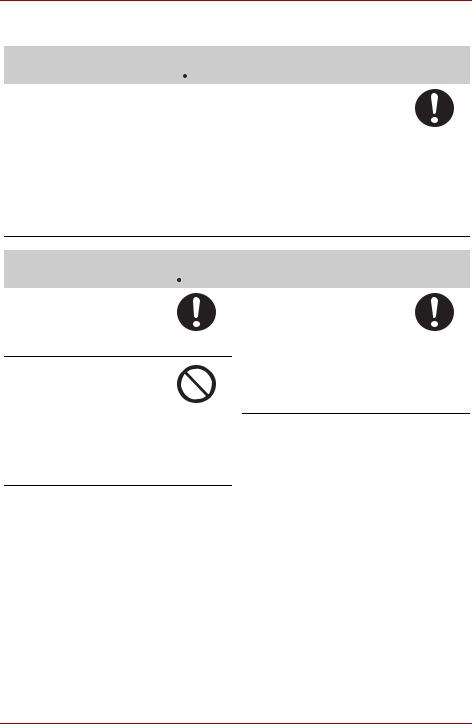
Hard Disk Camera GSC-K80HE/GSC-K40HE
About the camera battery and remote controller’s battery
 DANGER
DANGER
Observe the following when handling the camera battery and the remote controller’s coin-shaped battery
• Do not disassemble/modify
•Do not heat
•Do not throw in fire or water
•Do not hammer, step on, drop, or subject to strong impact
•Do not use in applications other than specified
•Do not recharge in any manner other than specified
•Do not connect the battery electrodes (+ and - terminals) with wire or other metallic objects
•Do not carry or store together with metallic necklaces or pins
This might cause the battery to rupture, ignite or heat up, resulting in fire or serious injury.
 WARNING
WARNING
Use only the specified battery (GSC-BT6/BT7).
Use of a battery other than specified might cause fire, damage, or malfunction.
Do not leave the remote controller’s lithium battery within the reach of small children.
Swallowing the remote controller’s coin-sized lithium battery might cause poisoning. If you accidentally swallow the battery, contact a doctor immediately.
If fluid leaks from the camera battery or the remote controller’s coin-shaped battery and comes into contact with your eyes, immediately wash your eyes with clean, running water, and ask a physician for treatment.
Leaving your eyes in this
condition might cause eye damage.
Owner’s Manual |
xvii |

Hard Disk Camera GSC-K80HE/GSC-K40HE
 CAUTION
CAUTION
Do not remove the battery immediately after the camera has been used for a long time.
The battery becomes hot during use.
Touching a hot battery might cause burns.
Do not use unusable battery or discharged battery.
Otherwise, the battery may rupture, ignite or heat up, resulting in fire, burns, or injury.
Before storing the battery, attach insulating tape to both the plus (+) and (-) electrodes.
Storing battery as it is might cause the battery to leak fluid, heat up or rupture, resulting in burns or injury.
Insert the coin-shaped battery carefully making sure that its polarities (marked by + and -) are facing the correct way.
Inserting the battery with its polarities facing the wrong way might cause fire or injury, or damage to the surrounding area due to the battery rupturing or leaking.
Handling Your Camera
Before using the camera, carefully read and observe the “Safety Precautions” ( p.xiii) and the notes described below:
p.xiii) and the notes described below:
Avoid Using or Storing the Camera in the Following Places
Places subject to humidity, dust, and dirt
Places subject to direct sunlight
Places subject to high or low temperature
Places filled with highly flammable gas
Places near gasoline, benzene, or paint thinner
Places subject to strong vibration
Places subject to smoke or steam
Places subject to strong magnetic fields (near electric motors, transformers, magnets, etc.)
Places contacting chemicals (such as pesticides), rubber or vinyl products for a long period of time
Avoid Subjecting the Camera to Vibrations or Impacts
If the camera is subjected to strong vibrations, not only will the camera become damaged, there might also be a loss of hard disk drive data.
xviii |
Owner’s Manual |

Hard Disk Camera GSC-K80HE/GSC-K40HE
Prevent the Hard Disk Camera from Coming into Contact with Sand
If the camera comes into contact with sand, not only will the camera become damaged, it will also no longer be repairable.
Take special care when using the hard disk camera near seaside, sandy areas or places where sand dust is likely to occur.
Pay Attention to Condensation
Sudden changes in temperature, such as when you move the camera from a cold location to a warm one, water droplets (condensation) may form on the inside of the camera or on the lens.
When this occurs, turn the power OFF, and wait an hour before using the camera. If condensation forms on the SD Memory Card, remove the SD Memory Card, wipe off any condensation and wait a short time before using it again.
When Cleaning the Camera
To prevent the lens and the surface of the LCD monitor from being scratched, blow off any dust from them with a blower brush and lightly wipe with a soft dry cloth.
Clean the body of the camera with a soft dry cloth. Do not use volatile liquids such as paint thinner, benzene, or other harsh chemicals because these may cause deformation or remove the coating.
Be Careful of Magnetic Fields
Please do not allow items that are easily affected by magnetic fields to come close to the speaker of the camera; these include credit and cash cards, magnetic passes, computer diskettes, etc. Doing so could result in data loss and render the item unusable.
Do not allow objects such as magnets or speakers which produce magnetic fields to come close to the camera. This might cause damage, malfunctioning, or loss of memory contents.
Be Careful of Electromagnetic Waves
Do not use the camera near towers or high-voltage lines. This might cause poor video or audio quality.
Owner’s Manual |
xix |

Hard Disk Camera GSC-K80HE/GSC-K40HE
Handling the AC Adapter
Be sure to use only the specified AC adapter (SQPH20W10P-02). Using a different AC adapter might cause the camera to malfunction.
Before using the AC adapter, carefully read and observe the “Safety Precautions” ( p.xiii) and the notes described below:
p.xiii) and the notes described below:
Do not allow the connectors on the AC adapter to come into contact with any other metal object because this might cause a short circuit.
To connect the AC adapter, fully insert the DC plug on the AC adapter into the DC IN 10V terminal on the camera.
When disconnecting the AC adapter cable or DC plug, turn the power OFF, then disconnect while holding its plug. Do not disconnect by pulling the actual cable.
Do not drop the AC adapter or subject it to strong impact.
Do not use the AC adapter in very hot and humid places.
Do not insert the DC plug on the AC adapter while the battery is being used. Turn the power OFF first.
The AC adapter is for indoor use only.
Do not connect the supplied AC adapter to a device other than this camera.
The AC adapter may sometimes become warm during use. This is normal.
Buzzing noises may come from inside the camera. This is normal.
Do not use the AC adapter near a radio because it could interfere with the radio.
If you remove the battery or AC adapter while the camera is in operation, the date may be lost from the memory. If this happens, reset the date.
Specifications
AC adapter (SQPH20W10P-02)
Input: |
100 V to 240 V AC, 50/60 Hz |
Rated output: |
10 V DC, 2.0 A |
Operating temperature: |
32°F (0°C) to +104°F (+40°C) |
Storage temperature: |
-40°F (-40°C) to +140°F (+60°C) |
Dimensions: |
1.9 inches × 1.0 inches × 3.9 inches |
|
(49.5 mm × 25.5 mm × 99.5 mm) (W × H × D) |
Weight: |
Approx. 7.1 oz (200 g) |
MEMO
Use the power supply indicated on the supplied AC cable. When using power supply other than the displayed voltage in other countries/region, please purchase the AC cable that applies to the standard of the country/region.
xx |
Owner’s Manual |

Hard Disk Camera GSC-K80HE/GSC-K40HE
Handling the Battery
This camera uses a special rechargeable lithium-ion battery. It is referred to simply as “battery” in this manual.
When you use the battery, carefully read and observe the “Safety Precautions” ( p.xiii) and the notes described below.
p.xiii) and the notes described below.
The battery included with the camera does not come fully charged. Be sure to fully charge the battery before using the camera for the first time.
About Battery Use
The battery gradually discharges even when not used. Charge the battery one or two days before use.
To maximize the battery life, switch the camera OFF as often as possible when it is not being used.
In cold locations, the length of time the camera is operable decreases even with a fully charged battery.
Take along a spare fully charged battery.
Always keep the terminals clean.
If the battery is used for a long time, the battery itself will become warm. This is normal and not a malfunction.
The battery has a limited service life. The length of service life varies depending on product use and user settings. At normal temperatures (77°F (25°C)), the battery can be recharged approximately 300 times.
If you use the battery beyond its service life, you may notice that battery life becomes remarkably shorter, even if the battery is fully charged. If you notice that battery life has become remarkably shorter, even when the battery pack is fully charged, it is recommended that you replace the battery pack with battery model number GSC-BT6/BT7.
When not Using the Battery for a Long Time
When the battery is not in use for a lengthy period of time, be sure to remove it from the camera body. If the battery is left attached to the camera body or battery charger, a minute current will flow even if the power is turned OFF. This will result in over discharge and the battery may no longer be useable.
Store the battery in a cool place. We recommend a dry place with a surrounding temperature of 59°F (15°C) to 77°F (25°C). Avoid storing the battery in extremely hot or cold places.
Owner’s Manual |
xxi |

Hard Disk Camera GSC-K80HE/GSC-K40HE
Charging the Battery
Charging is done with the camera body or the separately sold charger. You must not charge the battery with any other charger.
When you use the battery for the first time or when the battery has not been used for a long time, be sure to charge the battery before use.
Use only the specified AC adapter (SQPH20W10P-02).
This battery does not need to be fully discharged or exhausted before being charged.
The battery may feel warm after it has been charged or immediately after being used. This is normal and not a malfunction.
The battery can be charged at temperatures between about +50°F (+10°C) and +86°F (+30°C) to obtain maximum battery performance.
Do not recharge a fully charged battery.
Getting the Most Out of Your Battery
Even when the camera is turned off, a very small current continues to flow. If you do not intend to use the camera for a long period, you should take the battery out of the camera. If the battery is left out of the camera for approximately 48 hours, the date, time and other camera settings may revert to the default values. Reset these settings before using the camera.
Battery performance that has been impaired by low temperatures will recover when the camera is returned to room temperature (77°F (25°C)).
Specifications
Lithium-ion battery (GSC-BT6)
Nominal voltage: |
7.2 V |
Nominal capacity: |
1200 mAh |
Operating temperature: |
+32°F (0°C) to +104°F (+40°C) |
Dimensions: |
1.5 inches × 1.6 inches × 1.0 inches |
|
(37 mm × 40 mm × 25 mm) (W × H × D) |
Weight: |
2.2 oz (63 g) |
xxii |
Owner’s Manual |

Hard Disk Camera GSC-K80HE/GSC-K40HE
About the Built-in Hard Disk Drive
This camera has its own built-in hard disk drive. Hard disk drive will also be referred to as “HDD” throughout this Owner's Manual. The hard disk drive is a precision component that is easily affected by impacts, vibration and environmental variations such as changes in temperature. Note the following when using the camera:
Avoid striking, dropping, vibrating or waving the camera around while it is operating or while it is idle. Doing so could result in camera damage, malfunctions or loss of stored data.
Do not turn the camera off while it is writing data to or reading data from the hard disk drive. Doing so could result in camera damage, malfunctions or loss of stored data.
Before formatting the hard disk drive, check the data stored on the hard disk drive carefully.
Formatting the hard disk drive completely erases all the data saved on the hard disk drive. Data erased during formatting cannot be recovered.
You should back up the data saved on the hard disk drive frequently in case of damage to the hard disk drive or any modification or erasing of the data.
Toshiba accepts no liability whatsoever for any loss or corruption of data stored on the hard disk drive.
It is recommended that you make a trial recording before recording content that is important to you. Play back the trial recording to ensure that the video and audio were recorded properly.
Using the Hard Disk Drive
It is recommended that you periodically save the files on the hard disk drive to a PC, CD or DVD and format the hard disk drive.
The hard disk drive is a high precision component and there is always a risk of partial damage to the disk depending on how it is used. At worst, it may become impossible to read or write data to the hard disk drive.
Accordingly, the hard disk drive should not be regarded as a permanent storage location for recorded files, but rather as a temporary storage location for viewing images before they are to be erased or copied for permanent storage onto a PC, CD or DVD, etc.
When files are repeatedly recorded onto the hard disk drive and erased, file distribution on the hard disk drive becomes fragmented and the amount of continuous free space decreases.
When this occurs, files that cannot be saved into a single block of free space are split into 2 or more parts during saving.
Increasing numbers of split files will slow down normal camera operation and may in some cases prevent the allocation of sufficient free space to save new files even after stored images are erased.
In this situation, copy the files on the hard disk drive onto a PC, CD or DVD, etc. and then format the built-in hard disk drive.
If you cannot record or playback images on the hard disk drive, please format the hard disk drive.
After formatted, the hard disk drive reverts to default and all the stored data are erased.
Owner’s Manual |
xxiii |
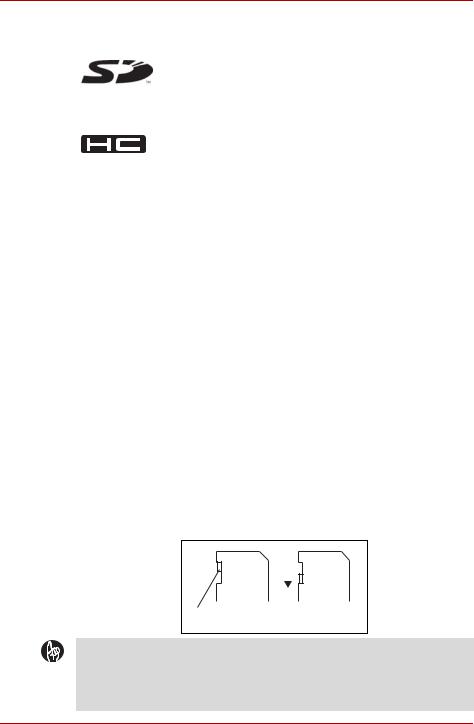
Hard Disk Camera GSC-K80HE/GSC-K40HE
About SD Memory Cards
SDHC/SD Memory Cards (sold separately) are referred to in this manual as “SD cards”.


 Note the information given below on handling SD cards.
Note the information given below on handling SD cards.
Notes on Using SD Cards
SD cards contain built-in nonvolatile semiconductor memory. Recorded data is not generally corrupted (or erased) during normal use, but misuse can result in data corruption (loss). Toshiba accepts no liability whatsoever for any damages or loss arising from the corruption (loss) of data stored on SD cards, regardless of the details or cause.
Because part of the memory on an SD card is used as the system area, the actual available memory capacity is smaller than stated card capacity.
Always format SD cards in the camera. Formatting an SD card on another device (such as a PC) can cause problems that may prevent data from being written to or read from the card.
You should always make backup copies of important data.
SD cards have a limited operating life. If you are no longer able to record or erase images on an SD card that has been used for a long period, you should purchase a new SD card.
Take care that young children do not accidentally swallow an SD card as this could cause choking.
This camera conforms to SD standard version 1.01.
Write-protection
To prevent important data from being accidentally erased, you can lock (write-protect) an SD card by moving the write-protect tab on the side of the card to the LOCK position. To record, edit or erase data on the card, return the tab to the unlocked position.
|
|
LOCK |
|
|
LOCK |
|
|
|
|
||
|
|
|
|
|
|
|
|
|
|
|
|
Write-protect tab |
|
|
Locked |
||
IMPORTANT
The use of Class 4 or Class 6 SD cards is recommended. However, recording might discontinue because of different situations.
Not all third-party SD cards are guaranteed to work with this camera.
xxiv |
Owner’s Manual |

Hard Disk Camera GSC-K80HE/GSC-K40HE
Chapter 1
Preparation
Component Names
Loading and Removing the Battery
Charging
Inserting and Removing SD Cards
Turning the Camera On and Off
Setting the Date and Time
Creating Albums
Using the LCD Monitor
About the Remote Control
Using the Conversion Lens or Lens Hood
Owner’s Manual |
1 |
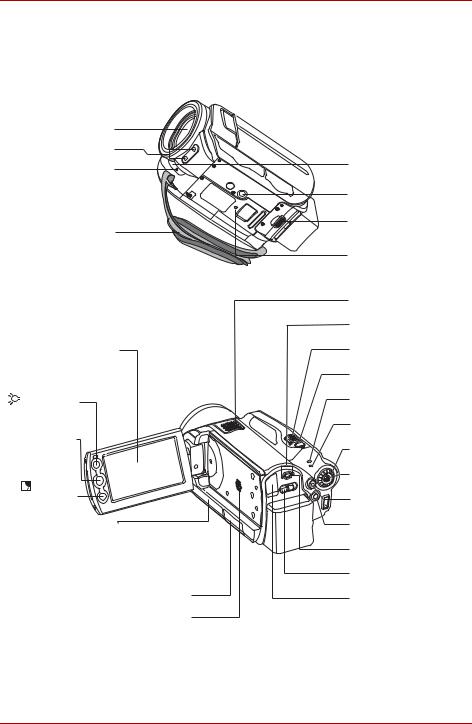
Hard Disk Camera GSC-K80HE/GSC-K40HE
Component Names
Camera
Lens
Assist light
Front LED
Grip belt
LCD monitor
(assist light) button
AUTO mode button
 (backlight compensation) button
(backlight compensation) button
Terminal cover
•HDMI terminal
•Component terminal
•A/V OUT terminal
•USB terminal
SD card cover
Speaker
Remote control sensor (embedded)
Tripod screw socket Battery lock lever
Reset switch
Microphone
Mode LED
Zoom lever
REC  button
button
STATUS LED
MEDIA LED
Jog dial
OK button
REC  button
button
MENU button
Mode button
POWER switch
Terminal cover
• DC IN 10V terminal
2 |
Owner’s Manual |

Hard Disk Camera GSC-K80HE/GSC-K40HE
Using the OK Button
Pressing directly down on the OK button confirms the selected item, but you can also
move it up  , down
, down  , left
, left  and right
and right  .
.
Use the OK button in recording mode to adjust the focus, select the scene, set the brightness, and to select items from menus.
In this manual, the “ ,
,  ,
,  ,
,  ” symbols are used to indicate the direction in which the OK button should be moved.
” symbols are used to indicate the direction in which the OK button should be moved.
Camera LEDs
|
Mode |
|
|
STATUS LED |
|
|
MEDIA |
Front LED |
|
|
LED |
|
|
|
|
|
|
LED |
|
Color |
Green |
Red |
Orange |
|
|||||
|
|
|
|||||||
Status |
Lit |
Lit |
Blinking |
Lit |
Blinking |
Lit |
Blinking |
Lit |
Lit |
At power |
- |
Charging |
- |
Charging |
- |
charging |
- |
- |
- |
OFF |
|
completed |
|
|
|
error |
|
|
|
Standby |
- |
- |
On |
- |
- |
- |
- |
- |
- |
|
|
|
standby |
|
|
|
|
|
|
During |
Recording |
- |
- |
- |
Hardware |
- |
- |
Media |
Recording |
shooting |
mode |
|
|
|
fault |
|
|
access |
|
During |
Playback |
- |
- |
- |
Hardware |
- |
- |
Media |
- |
playback |
mode |
|
|
|
fault |
|
|
access |
|
In USB |
- |
Mounted |
- |
- |
Hardware |
- |
Cable not |
Media |
- |
mode |
|
|
|
|
fault |
|
connected |
access |
|
Owner’s Manual |
3 |
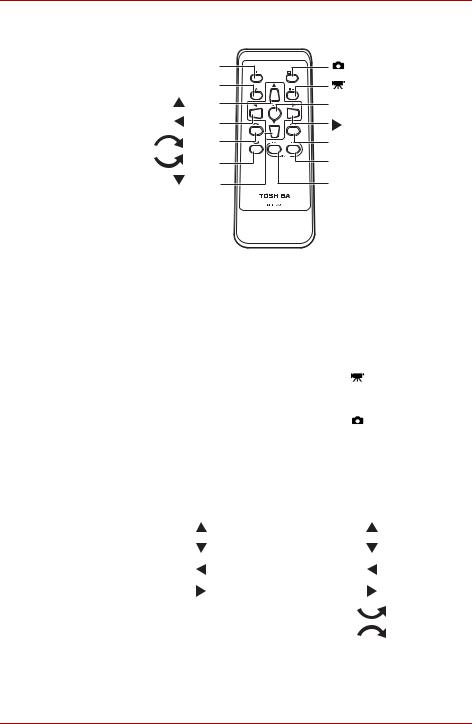
Hard Disk Camera GSC-K80HE/GSC-K40HE
Remote Control
T button |
REC button |
W button |
REC button |
button |
OK button |
button |
button |
button |
MENU button |
button |
MODE REC button |
button |
MODE PLAY button |
|
|
|
|
|
|
|
Buttons/levers |
|
|||
|
Camera |
|
|
|
Remote control |
|
POWER |
|
|
|
- |
Mode button |
|
|
|
MODE REC |
|
|
|
|
|
|
|
|
|
|
|
|
MODE PLAY |
|
REC |
|
|
|
REC |
REC |
half-pressed |
|
|
|
- |
REC |
fully pressed |
|
|
|
REC |
Zoom lever T direction |
|
|
|
T |
|
Zoom lever W direction |
|
|
|
W |
|
|
MENU |
|
|
|
MENU |
|
OK |
|
|
|
OK |
OK button |
|
|
|
|
|
OK button |
|
|
|
|
|
OK button |
|
|
|
|
|
OK button |
|
|
|
|
|
|
Jog dial left |
|
|
|
|
Jog dial right |
|
|
|
|
|
4 |
Owner’s Manual |
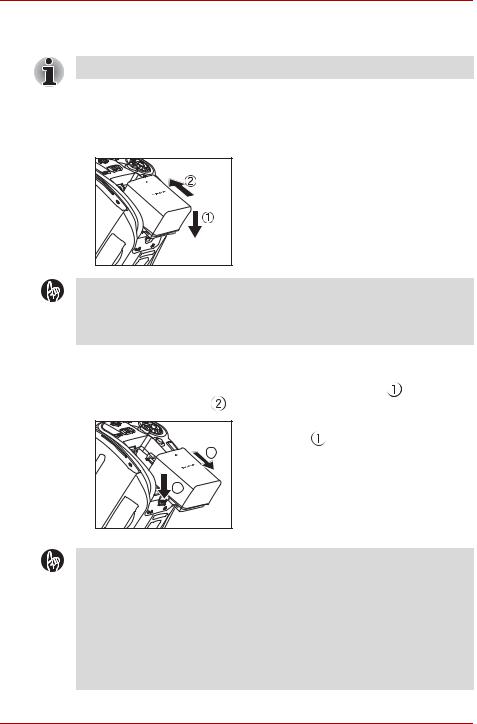
Hard Disk Camera GSC-K80HE/GSC-K40HE
Loading and Removing the Battery
Check that the camera is turned off.
Loading the Battery
1.Use the battery to push the battery lock lever in the direction of the arrow  as you slide the battery in
as you slide the battery in  .
.
Load the battery firmly as far as it will go, and check that the battery is secured by the battery lock lever.
IMPORTANT
If you load the battery when the camera has not been correctly shut down, the camera may not operate correctly. In this event, turn the camera off and on again.
Removing the Battery
1. Slide the battery lock lever in the direction of the arrow |
|
and then |
remove the battery in . |
|
|
|
|
2 |
1 |
IMPORTANT |
Hold the battery lock lever in the direction of the arrow to release the battery and then remove it.
Always turn the camera off before removing the battery. Removing the battery while the camera is still turned on may damage the camera or corrupt important data. It may also cause the camera settings to revert to the defaults that were set when you purchased the camera. If this occurs, specify your preferred settings again.
When removing the battery, take care not to drop the camera or battery.
If you slide the battery lock lever when an AC adapter is not connected, the power will automatically go off.
Owner’s Manual |
5 |
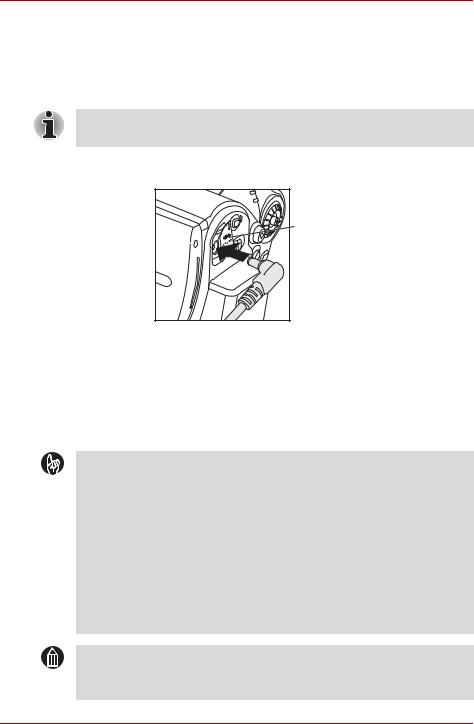
Hard Disk Camera GSC-K80HE/GSC-K40HE
Charging
You should charge the battery the first time you use the camera and whenever the battery is low. Charging the battery fully takes around
2.5 hours. Time needed for recharging increases or decreases depending on factors including the surrounding temperature.
Check that the battery is loaded in the camera and that the camera is turned off.
Charging in the Camera
Terminal cover
1.Open the terminal cover on the camera.
2.Connect the power cord and AC adapter and then plug the power cord into the mains power socket.
3.Plug the DC plug on the AC adapter into the DC IN 10V socket on the camera.
When battery charging begins, the STATUS LED on the camera lights red. When charging is completed, the STATUS LED on the camera turns green.
IMPORTANT
The battery is charged while in the camera. Never attempt to charge the battery with any other charger.
If a problem arises during charging, unplug the power cord from the mains power outlet, remove the battery from the camera and contact Toshiba Customer Service Department or Toshiba Customer Support Department. Be careful when removing the battery as it can become hot.
If the camera is charged in conditions where it becomes hot (in direct sunlight, etc.), the heat in the camera may trigger a sensor in the camera that prevents charging from beginning immediately. If this occurs, allow the camera to cool fully before charging.
MEMO
To get the best possible performance from your battery, charge it when the ambient temperature is between 50°F (10°C) and 86°F (30°C).
6 |
Owner’s Manual |
